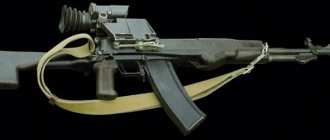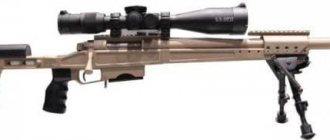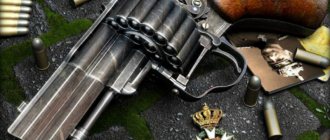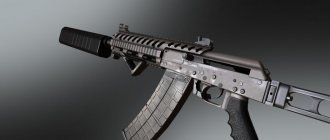The situation in the modern world is such that the Russian Federation, in order to maintain its sovereignty and play key roles in the international arena, is forced to strengthen its combat capability. What is strengthening combat capability? This is, first of all, strengthening the Russian army with new weapons - classified types of weapons, and those that Russia sells to other countries.
This article will discuss the latest weapons developments in Russia. Some of these weapons are already in use by our troops, other new models are at the development and testing stage, and should enter service with the Russian army in 2020-2019.
Here it should be said again that Russia is currently developing and testing many types of new generation weapons, and testing new weapons in Russia is a secret matter. For obvious reasons, nothing can be said about such weapons yet. In addition, it is simply impossible to talk about all new developments in a separate article, so we will only talk about some of the most high-profile examples of modern Russian weapons.
The latest weapons of Russia 2017-2018
Generally speaking, according to prominent arms experts and politicians, in the coming years the Russian armed forces should receive:
- More than 600 aircraft of different types: fighters, long-range aircraft, strategic bombers, etc.;
- More than 1000 of the latest helicopters;
- More than 300 new super-air defense systems;
- New generation ballistic missiles with nuclear warheads;
- New nuclear weapons;
- New high-precision weapons (bombs, missiles, etc.), as well as the latest guidance systems for such weapons, designed for high-precision shooting;
- New weapons to destroy tanks and other ground vehicles;
- The latest models of small arms and military equipment;
- Various new generation military equipment, as well as other products from domestic arms manufacturers.
In addition, the Russian Armed Forces should soon receive automated command and control systems. Russia is also developing a new secret weapon. According to some information, the latest Russian small arms are currently being developed, the operation of which is supposed to be based on fundamentally new physical methods.
In addition, work continues on the creation of hypersonic missiles, which are supposed to be based not on the surface of the earth, but in the airspace. It is assumed that the speed of such missiles will be 7-8 times higher than the speed of sound. This, for obvious reasons, will be Russia's newest secret weapon.
In addition, work is underway in Russia on other types of superweapons. Some of these types of Russian superweapons will be discussed below.
We've arrived
For the first time, a research and production company will go to a shipbuilding plant in the Arkhangelsk region. Conscripts will build nuclear submarines. The company consists of conscripts with secondary vocational education. All of them graduated from the technical school of shipbuilding and mechanical engineering in Severodvinsk.
Source: globallookpress.com
They will begin working at the enterprise after taking the oath. Recruits will spend half a day doing military training, and half a day working as turners, millers, and hull assemblers. The emergence of a company will allow servicemen to retain their working skills, and the enterprise of the defense-industrial complex will provide itself with young personnel.
Russian nuclear weapons
It is known that the main shield of our country is strategic nuclear weapons. The well-known domestic models of strategic nuclear weapons “Voevoda” and “Sotka” are still serving well today. However, they are already being replaced with more advanced models (“Topol”, “Topol-M”).
However, in addition to those listed, Russia’s new secret weapons, that is, new models of strategic missiles, are now being actively and successfully developed and implemented. Here are just a few of them:
- RS-24 Yars. The rearmament of the Russian army with such missiles is, in fact, already underway. According to the Russian command, missiles of this type will replace outdated models of strategic missile weapons (the same “Topol” and “Topol-M”);
- RS-26 Rubezh. This complex is designed to use an intercontinental ballistic missile with increased firing accuracy. In 2014, the complex entered service with the Russian army. It is assumed that this missile will in the future replace the Topol-M and Yars;
- BZHRK Barguzin. Since this type of weapon is not yet used in the Russian army (it is under development), there is little information about it. This new Russian secret weapon is expected to be operational in 2022;
- Vanguard rocket launcher. This is a fundamentally new weapon, its effectiveness compared to the same “Topol-M” can be 50 times higher. The warhead of this missile is capable of flying from 16 to 25 thousand km. The missile launcher is expected to be put into service in 2020;
- Bottom missile systems. These are, in fact, missile launchers located on the seabed and, accordingly, launch missiles from the depths of the sea. One of these complexes was named “Skif”. The essence of the action of such a complex is as follows. The rocket, located on the seabed, is in constant standby mode. When the command is fired, the missile fires and hits a surface ship or some ground target. The water column serves as a kind of shaft for the rocket. The first test launch of the rocket since the White Sea was carried out back in 2013. The development of bottom missile systems continues to this day;
- Mobile missile systems. Based on the name, such complexes can be moved from place to place, which is their considerable advantage compared to stationary complexes. In Russia, work is currently underway on the creation of railway and sea mobile missile systems. One of the trial sea mobile missile systems was placed in an ordinary cargo container. The test launch of a rocket from such a complex produced a considerable effect among observers and experts.
Let us repeat: all this is only a small part of the missile weapons put into service in 2022 or planned to enter the Russian armed forces in the near future.
Anti-tank weapons
As for anti-tank weapons, there are also unique samples that have no analogues anywhere in the world. Here are just a few of these samples:
- Missile system Kornet-D. This is a very effective weapon for destroying enemy armored vehicles. Since the complex is a missile system, it follows that the destruction of enemy armored vehicles is carried out by missiles;
- Hermes complex. Its first version, called "Hermes-A", was intended to be destroyed using helicopters. The complex is attached to a helicopter, and in this way fire is fired at enemy armored vehicles. Currently, work is underway to create new variants of ATGMs, which are designed to expand and diversify the use of weapons. In particular, it is known that in the near future, missiles fired from the Hermes complex should be used from the Pantsir-S1 anti-aircraft missile system;
- MGK BUR. Essentially, this is a new and improved type of grenade launcher, which has a reusable launcher and one shot. That is, after each shot, the grenade launcher must be reloaded, as was the case in all previous versions of this type of weapon.
Other types of anti-tank weapons that are currently being worked on are classified, and therefore there is no need to talk about them in detail.
Daggers on the "Tushka"
They decided to modernize the long-range supersonic bomber Tu-22M3. It will carry four Kinzhal hypersonic missiles. To do this, the aircraft will be re-equipped and made into a platform for an increased number of new missiles. For the first time, “Daggers” on MIG31K (pictured) were shown at the recent May 9 parade in the sky over Red Square.
Source: kremlin.ru
Four Kinzhals on one bomber will become a more effective weapon against aircraft carrier groups and will be able to hit targets protected by air defense and missile defense. The hypersonic Kinzhal itself is practically indestructible; it is impossible to intercept such a missile at high speed in the atmosphere. In the event of war, it will be the means of destroying infrastructure in the rear, paralyzing the enemy’s actions, blocking the transfer of troops and equipment. Modernization of the Tu-22M3 is beneficial from an economic point of view, since there is no need to spend money on creating a new machine.
New small arms
When speaking of “Russia’s new weapons,” it is impossible to avoid mentioning the new small arms produced in the country. Missiles, planes and ships are, of course, wonderful, but it is small arms that are primarily capable of protecting the most valuable thing - the life of a soldier. Here are just some of the new models of Russian small arms:
- Double-medium ADS machine. This is a unique new Russian small arms that can fire both in the open air and under water. In addition, the machine gun is designed in such a way that it can be fired from both the left and right hands. Serial production of the assault rifle began in 2016, and it entered service with the Russian army in 2022;
- SVLK-14S. This rifle is an exceptionally accurate Russian sniper weapon, which can effectively hit a target at a distance of up to 2 km. In addition, it is the most powerful small arms to date;
- Lebedev pistol (PL-14). Domestic pistols are perhaps the weakest point of our small arms. The famous “Makarov” has long been outdated - both in terms of its fighting qualities and in other senses, there are also complaints about other domestic pistols. Against this background, the new domestic pistol, developed by designer Lebedev, looks very attractive. The pistol is very light and thin, it can be fired with both the right and left hand, it has little recoil, the accuracy of fire and the rate of fire are superior to existing domestic analogues. The pistol should enter service with both the army and the police. In addition, the designers also promise a sports version of the PL-14.
Currently, several defense enterprises in the country are working on the creation of a fundamentally new small arms, in no way similar to the famous Kalashnikov assault rifle. In particular, it is already known that such a weapon will have a striking mechanism and buttstock in the stock, and such weapons are supposed to be fired with specially designed (innovative) cartridges. Such cartridges will have significantly increased accuracy and firing range, as well as destructive power. The first samples of such weapons have already entered the Russian armed forces this year. Massively new small arms will begin to enter the army and special forces in 2022.
"Rook" will arrive
On Navy Day in St. Petersburg, the anti-sabotage boats of the Northern Fleet “Rook” will take part in the main naval parade. They will have to make a difficult transition from the White Sea to the Baltic Sea along the White Sea-Baltic Canal.
The boat is armed with a cannon, two grenade launchers and an Igla MANPADS. Source: vympel-rybinsk.ru
It was these ships that took part in the operations of Russian troops in Syria. They defended the Tartus naval base around the clock, and also participated in the search for the Su-30SM fighter that fell into the sea in May of this year. "Grachonok" is designed to combat underwater saboteurs in the waters of fleet bases and coastal areas.
Yaroslav Filippov, Mikhail Vasiliev
#28/2018 military correspondent military equipment Russian weapons photo eg.ru
Robots as Russia's newest weapon
It is clear that in the age of electronic technology, robots can (and must) also be weapons. Which is exactly what is happening. This year, Russia began creating special forces robots. According to the designers, such robots will be able to provide significant assistance to soldiers on the battlefield: helping snipers in choosing a target, delivering ammunition, and also performing the functions of orderlies - that is, finding the wounded, providing them with first aid and transporting them to medical facilities. Such robots are currently being tested.
Another combat robot (or rather a robotic military complex), which was given the name “Nerekhta”. It moves on tracks and is armed with a Kord machine gun. Initially, the robot was conceived as an artillery fire spotter, but the designers soon realized that for such a machine being just a spotter was not enough.
Currently, the Nerekhta robot can go on reconnaissance, quietly destroy an enemy pillbox, open fire with a machine gun, and thereby support its fighters. The robot is capable of moving up to 30 km per hour and is controlled via a remote control. Since the robot is equipped with an optical-electronic system, a thermal imager, a laser range finder and a ballistic computer, it is currently also successfully used as a guard for missile systems.
Currently, work is underway to improve the robot. Thus, this year an improved version of Nerekhta-2 was tested. Such a robot will be the fighter’s “squire,” that is, he will carry the fighter’s weapons and equipment. The robot can be controlled by voice and gestures. In addition, the robot will act in sync with the fighter it is serving. For example, if a fighter took aim and shot at a target, then the robot will also shoot at the same target with its weapon - for reliability and safety net.
The Turks may leak the F-35 secret to Russia
Military experts in the United States and Great Britain are in a panic - they believe that Russia, with the help of Turkey, can gain access to the secret technologies of the American F-35 fighter. After all, Turkey plans to buy both Russian S-400 air defense systems and American stealth aircraft. Having received them, local specialists will know exactly how effective Russian weapons are against the “flying Yankee.” Strong pressure has already begun on Turkey to abandon the acquisition of the S-400. But wherever you sit on Erdogan, you will get off. The Turks have already declared that they will not fall for blackmail.
By the way, many believe that the F-35's reputation is inflated. In Yugoslavia, during NATO raids, this pretentious plane was shot down by an old Soviet missile. And six months ago, the Israelis wrote off one F-35, saying that “a bird hit it.” Many experts believe that it could have been shot down.










!['Domestic small arms [studio "Wings of Russia"] (2011)'](https://knifesburg.ru/wp-content/uploads/otechestvennoe-strelkovoe-oruzhie-studiya-krylya-rossii-2011-330x140.jpg)
